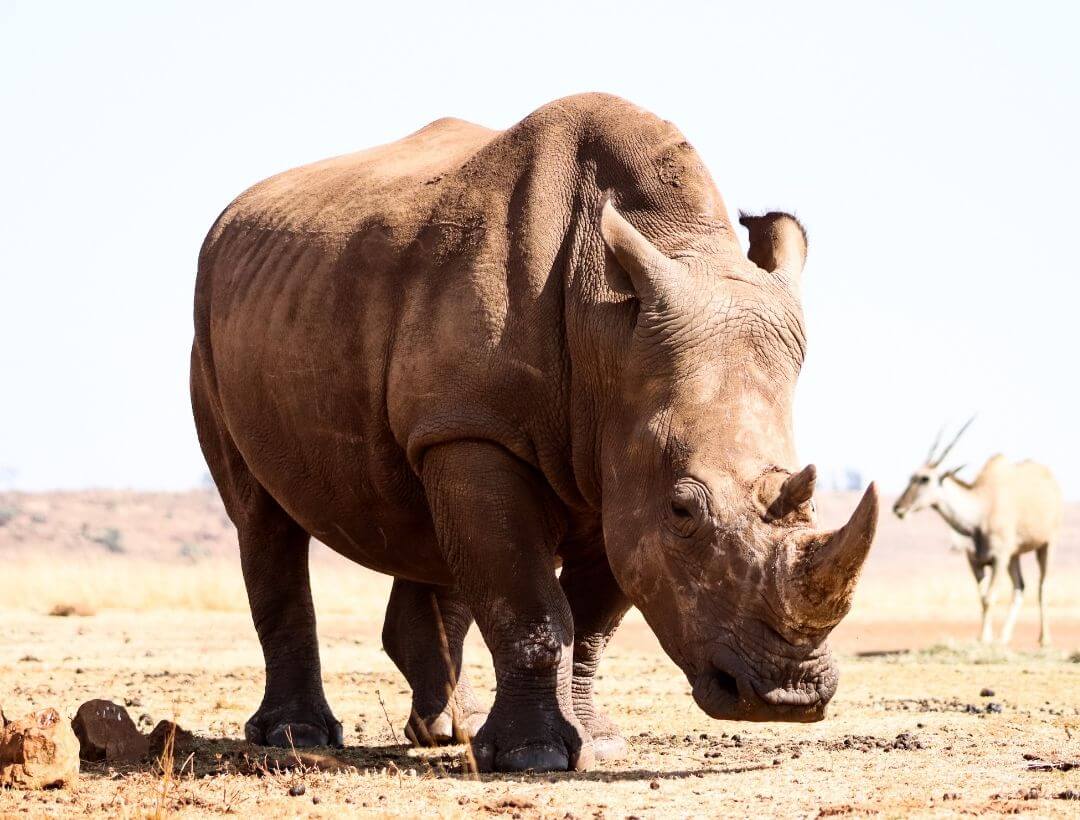Northern White Rhinoceros Conservation Story
Northern White Rhinoceros
Conservation Story
Amazing News for the NWR
Ol Pejeta Conservancy
Lawn Mowers of the Savanna
- They are one of two subspecies of white rhinoceroses, the other being the southern white rhino (population ~20,000)
- White rhinoceroses are the largest living rhino species and one of the largest land mammals!
- They have a wide, flat lip
- They are known to be grazers of grasslands and savannas, eating huge amounts of grass
- Rhinoceroses have horns on their face which are made of keratin, the same materials as our hair and nails
- They have thick skin that they coat in mud to protect themselves from the sun and bugs
- Despite their size, they are very fast, reaching speeds of 30 mph
- A group of rhinos is called a crash
So, What's the Problem?
White rhinoceroses saw a massive decline in the 1500s when they were aggressively hunted for sport and their horns. The northern white rhinoceros population continued to decline, dropping to 15 individuals by the 1980s. Today, they battle...
1
Poaching
For thousands of years, rhinoceros populations have been destroyed by hunting for their horns. Rhinoceros horns are made of keratin, the same proteins that make up our hair and nails but have long been thought to have medicinal value. It has been used to treat fevers, high blood pressure, food poisoning, and arthritis, though does not actually have any curing powers. Horns are also prized as trinkets and jewelry in some cultures. Today, poaching is the largest threat against rhinos, killing more than 900 per year and selling for $50,000 USD/lb.
2
Habitat Loss
Rhinoceroses have been pushed out of most of of their historical range due to the expansion of human settlements and agriculture in southern Africa. As humans move in and grow their communities, they need more resources and land to produce them. Overgrazing from herds of livestock and lumber needs resulting in deforestation, much of the white rhinoceros's habitat is becoming uninhabitable. In order to have stable, self-sustaining white rhinoceros populations, you need a large and efficient habitat for them to roam.
Today, there are only two northern white rhinoceroses left in the world.
The mother and daughter pair named Najin and Fatu live in a conservancy in Kenya under 24/7 armed guard.
How Did We Get Here?
After spending a long time under threat, the population of northern white rhinos was just over 2,000 individuals as of the 1960s. Civil wars and relentless poaching continued to decimate the rhino populations, leaving only about 15 individuals in a small region of the Democratic Republic of the Congo by the mid-1980s.
Through extreme concern for the survival of their subspecies, several organizations joined together to help recover the species. Over the next decade, the population of northern white rhinoceroses rose to roughly 30! With intense regulations and protections, their population remained stable until 2003, when a population survey only counted about 20 rhinos in the park.
A proposal to relocate a small group of the rhinos to a protected space was declined in late 2004 and because of park management issues and a lack of security, many organizations had no choice to but withdrawal from the recovery efforts. By 2006, only 4 northern white rhinoceroses remained and by 2007, there were no signs of a single rhinoceros.
Luckily for the northern white rhino, there were six remaining in captivity in the Czech Republic and it was time to get to work.
Saving the Northern White Rhino
In December 2009, four of the six captive rhinoceroses were moved from the Czech Republic to a conservancy in Kenya. Two others lived at the San Diego Zoo but were not eligible for breeding.
The two male and two female rhinoceroses were moved in an effort to stimulate breeding behaviors being in a more natural environment.
Breeding was unsuccessful and one of the males passed away from natural causes in 2014 and the other in 2018, making the natural reproduction process impossible.
Biologists had been collecting reproductive materials from both males and female northern white rhinoceroses in the captive population. These sperm and eggs have been kept in "frozen zoos."
Reproductive materials have been shared from the San Diego Zoo, the Dvůr Králové Zoo in the Czech Republic, and the Ol Pejeta Conservancy in Kenya to provide as much opportunity as possible.
Northern White Rhino Progress
2017
Meetings between wildlife biologists and veterinarians began to discuss the process of extracting eggs from the last two remaining northern white rhinoceros females and prepared for in vitro. They would be fertilized by sperm stored from a male that had passed away
2018
The last male northern while rhinoceros died of age related causes, leaving just the two females.
Scientists successfully produced an embryo using eggs from a southern white rhino and sperm from a northern white rhino, theoretically proving its possibility with all northern white rhinoceros material
2019
In August, veterinarians and biologists collected eggs from both of the last female northern white rhinoceroses. A total of 10 eggs were taken.
Two days after the eggs were collected, 7 of the 10 were successfully fertilized with the sperm of two northern white rhino males, with 2 resulting in embryos
The procedure was performed again in December, collecting 9 egg cells which resulted in one successful embryo
Scientists begin steps for identifying a group of southern white rhinoceros females to be surrogate mothers to northern white rhinoceros offspring
2020
After a break in recovery efforts due to the COVID-19 pandemic, a third egg retrieval was performed in August. They collected 10 more egg cells and plans are still underway identifying a group of surrogate mothers
Do Your Part for Rhinos
Avoid Rhino Products
This is obviously the easiest way to protect rhinos. If there is no demand for rhinoceros products, then there is no need to collect the product.
Shop Sustainably
Shop. Sustainably. Wood, paper, palm oil... Pretty much every item we use throughout the day has a sustainable and a not-so-sustainable option. Use these apps to make sure your products are not destroying rhino habitat.
Donations
One of the best ways to help rhinos is to donate. Rhinoceros conservation is very expensive work. Donate to Ol Prejeta Conservancy, World Wildlife Fund, or San Diego Zoo Global
Sign Up for our Newsletter
Stay up to date with new adventures, classes, deals, and more!
MENU
EDUCATIONAL RESOURCES
© 2024
All Rights Reserved | Edzoocating.com





